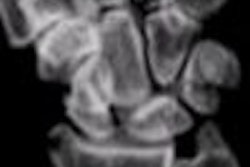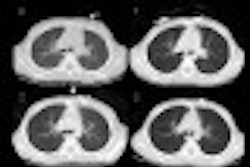A formal policy for imaging pregnant patients with ionizing radiation has helped the University of Iowa Hospitals balance the benefits and risks of the exams. It has also enhanced overall communication between patients and doctors.
The 6-month-old policy "has been successful in eliminating ambiguity, facilitating communication between radiologists and referring physicians and in the prudent counseling of our pregnant patients," said Meghan Blake in a presentation last month at the 2002 American Roentgen Ray Society meeting in Atlanta. Blake, a medical student at the university, co-authored the policy. The lead authors were Dr. George El-Khoury, director of musculoskeletal radiology, and physicist Mark Madsen, Ph.D.
"Why is such a policy necessary? Imaging women and the risk of fetal exposure are not new issues," Blake added. "Yet the imaging tools are radically different than those used several decades ago when these issues were first addressed. The growth of CT technology in particular spurred the development of our policy. While CT is considered a high-dose procedure, delivering between 1-10 rems to the patient, it is also widely coming to be regarded as a first-line imaging modality."
At her institution, 400-450 CT exams are performed each week. While CT accounts for about 4% of all imaging exams, it also accounts for 35% of delivered radiation dose, she said.
The bulk of the policy is based on four categories, or scenarios, that should be applied to the patient once it has been determined that she is pregnant:
- Scenario A: For exams above the abdomen or below the hips, the patient should be assured that there is no scientific evidence that imaging will harm the fetus.
- Scenario B: For exams during which the fetus is in the direct beam and the calculated dose is less than 1 rem.
"(In Scenario B) the patient’s chart should reflect that other modalities have been considered and that (the ionizing radiation) exam has been deemed essential for medical management. The patient should be assured that the dose is small and will be kept within the lowest level consistent with obtaining diagnostic information," Blake said.
- Scenario C: For exams in which the fetus is directly in the beam and the estimated dose is between 1-5 rem, such as fluoroscopy, abdominal or pelvic CT, and angiography. At this level of exposure, the patient should be made aware that the risk to the fetus is small but real, and she should take part in the decision-making process.
- Scenario D: For exams during which the estimated dose to the fetus exceeds 5 rems, including long fluoroscopy exams or repeated CT tests. In this case, a radiation physicist should be consulted and the patient should be counseled as to the fetal risk. The referring physician, the radiologist, and the physicist should write separate notes in the patient’s chart explaining the circumstances and why the exam is medically justified.
Two patient consent forms are used for scenarios C and D, Blake said. For C, the form states that "radiation of the fetus at this dose level is associated with minimally increased risk of childhood cancer, congenital abnormality, mental retardation and small head size, and miscarriage. The form for D refers to "increased risk."
Two appendices in the policy lay out the parameters for estimated fetal dose, including optimal views, slice thickness, kVp, and mA measurements for multislice and helical CT.
The policy has been well received by the obstetrics and gynecology department, as well as the hospital’s legal department, Blake said.
During the discussion following the presentation, Dr. Claude Sirlin from the University of San Diego in California suggested another alternative for imaging pregnant patients: ultrasound. Sirlin and his colleagues have developed a protocol for the sonographic assessment of blunt abdominal trauma in female patients.
According to Sirlin’s criteria, a pregnant patient who is hemodynamically unstable can be imaged with ultrasound. If the exam shows fluid in the belly, she then goes on to laparotomy. Ultrasound can also be used in patients for whom the risk of serious injury is quite small, such as a low-velocity fall. In those cases, if the ultrasound is negative, the patient is admitted for overnight observation.
"If you aren’t comfortable with the negative ultrasound results, you can still go ahead and do a CT. The ultrasound didn’t cost you any time. In our experience with over 4,000 trauma patients in the last six years, we found that this protocol works very well," Sirlin said.
But in many cases commonly seen in an emergency setting -- such as an exam to rule out appendicitis or decipher the cause of right upper quadrant pain in any pregnant patient --CT is a better option, El-Khoury wrote in an email to AuntMinnie.com.
By Shalmali PalAuntMinnie.com staff writer
May 15, 2002
To obtain a copy of the policy, contact Dr. George El-Khoury.
Related Reading
Ultrasound disappoints in abdominal trauma, December 14, 2001
ICRP releases report on pregnancy and radiation, July 17, 2001
Pregnancy test advised for female trauma victims prior to radiation exposure, June 28, 2001
Helical CT accurately diagnoses acute appendicitis in pregnancy, June 7, 2001
Focused CT preferred over US for tracking suspected appendicitis in pregnant women, January 15, 2001
CT can diagnose kidney stones in later pregnancy at a lower radiation dose, November 26, 2000
Copyright © 2002 AuntMinnie.com



















